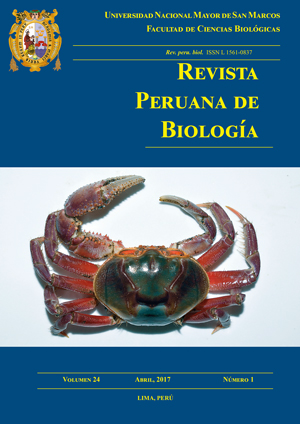Harmful algal blooms and Vibrio spp. association in fishing and marine farming areas of mollusk bivalves in Sechura and Pisco bays, Peru
DOI:
https://doi.org/10.15381/rpb.v24i1.13111Keywords:
temperature, nutrients, Vibrio, algal blooms, bivalve mollusks, maricultureAbstract
Between February 2010 and May 2014, 22 surveys in Pisco and 16 in Sechura were conducted; both are major areas for shellfish production and mariculture in Peru. The incidence of Vibrio in seawater was monitored during algal blooms and in their absence. Environmental parameters such as temperature and nutrients were measured. In Sechura, Pseudo-nitzschia seriata and Protoperidinium depressum caused algal blooms and were dominant throughout the evaluation period. The temperatures in this area ranged from 21.8 to 25.3 °C. In Pisco, the harmful algal bloom-forming Akashiwo sanguinea, Messodinium rubrum, and Prorocentrum minimum and the dinoflagellate Cochlodinium polikrykoides were most prevalent. Harmful algal blooms occurred when temperatures were between 17.1 and 23.3 °C, with phosphates ranging 1.22 - 6.85 µM and nitrates 0.15 - 7.85 µM. In May 2012, the dinoflagellate Alexandrium peruvianum caused an algal bloom, with temperatures ranging 18.0 to 23.2 °C, phosphate values from 0.73 to 11.56 µM, and nitrates from 0.76 to 9.81 µM. Coliforms were low, < 2 - 23 MPN/100 ml, in both bays throughout the study period. Vibrio alginolyticus was the dominant Vibrio spp. predominated in both bays, while V. vulnificus and V. parahaemolyticus were detected in Pisco, where warmer sea temperatures are common and severe infections cases by seafood ingestion has been associated with a pathogen V. parahaemolyticus.Downloads
Downloads
Published
Issue
Section
License
Copyright (c) 2017 Rita Orozco, Yessica Quispe, Alberto Lorenzo, María Luz Zamudio

This work is licensed under a Creative Commons Attribution-NonCommercial-ShareAlike 4.0 International License.
AUTHORS RETAIN THEIR RIGHTS:
a. Authors retain their trade mark rights and patent, and also on any process or procedure described in the article.
b. Authors retain their right to share, copy, distribute, perform and publicly communicate their article (eg, to place their article in an institutional repository or publish it in a book), with an acknowledgment of its initial publication in the Revista Peruana de Biologia.
c. Authors retain theirs right to make a subsequent publication of their work, to use the article or any part thereof (eg a compilation of his papers, lecture notes, thesis, or a book), always indicating its initial publication in the Revista Peruana de Biologia (the originator of the work, journal, volume, number and date).


















